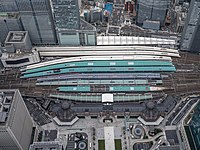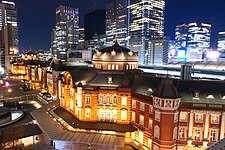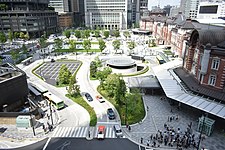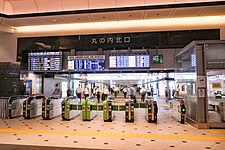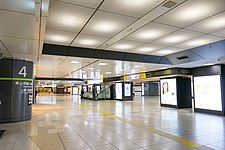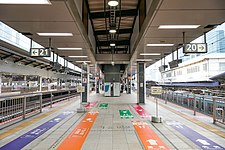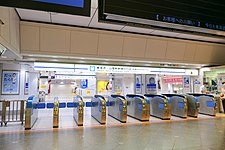Tokyo Station
Tōkyō Station Đông kinh dịch | |||||
|---|---|---|---|---|---|
 Tokyo Station's Marunouchi side in June 2023 | |||||
| General information | |||||
| Other names | Tokyo Central Station | ||||
| Location | Chiyoda,Tokyo Japan | ||||
| Operated by | |||||
| Connections | |||||
| History | |||||
| Opened | December 20, 1914 (JGR) March 20, 1956 (Tokyo Metro) | ||||
| |||||
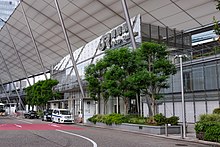

Tōkyō Station(Japanese:Đông kinh dịch,pronounced[to̞ːkʲo̞ːe̞kʲi]) is a major railway station inChiyoda, Tokyo,Japan. The original station is located in Chiyoda'sMarunouchibusiness district near theImperial Palacegrounds. The newer Eastern extension is not far from theGinzacommercial district. Due to the large area covered by the station, it is divided into the Marunouchi (west) and Yaesu (east) sides in its directional signage.
Served by thehigh-speed raillines of theShinkansennetwork, Tōkyō Station is the maininter-city railterminal in Tokyo. It is the busiest station in Japan in terms of scheduled trains, with more than 4,000 trains arriving and departing daily,[1]and the fifth-busiest in eastern Japan in terms of passenger throughput;[2]on average, more than 500,000 people use Tōkyō Station every day.[1]The station is also served by many regional commuter lines ofJapan Railways,as well as theTokyo Metronetwork.
Lines
[edit]Trains on the following lines are available at Tōkyō Station:
 JR East
JR East
 Tōhoku Shinkansen
Tōhoku Shinkansen Yamagata Shinkansen
Yamagata Shinkansen Akita Shinkansen
Akita Shinkansen Jōetsu Shinkansen
Jōetsu Shinkansen Hokuriku Shinkansen
Hokuriku Shinkansen Hokkaido Shinkansen
Hokkaido Shinkansen- JTTōkaidō Main Line
- JUUeno–Tokyo Line
- JKKeihin–Tōhoku Line
- JYYamanote Line
- Chūō Main Line(includingJCChūō Line (Rapid))
- Sōbu Main Line(includingJOSōbu Line (Rapid),Limited ExpressNarita Express,Shiosai)
- JOYokosuka Line(including Limited ExpressNarita Express)
- JEKeiyō Line
 JR Central
JR Central
 Tōkaidō Shinkansen(through services to/fromSan'yō Shinkansenoperated byJR West)
Tōkaidō Shinkansen(through services to/fromSan'yō Shinkansenoperated byJR West)
 Tokyo Metro
Tokyo Metro
The station is linked by underground passageways to theŌtemachiunderground (subway) station complex served by theTōzai,Chiyoda,Hanzōmon,andMitasubway lines.
It is also possible to walk to theNijūbashimae,Hibiya,Yūrakuchō,Ginza,andHigashi-ginza Stationscompletely underground (the last a distance of over 2 km (1.2 mi)), but these stations can usually be reached more quickly by train.
Tokyo Station is also a major intercity bus terminal, with regular midday service to several cities in theKantō regionand overnight service to theKansaiandTōhoku regions.The furthest overnight bus service goes toIzumo-Taisha,over 800 km (500 mi) away.
Station layout
[edit]The main station facade on the Marunouchi side is made primarily of bricks, and partly dates back to the station's opening in 1914. The main station consists of tenisland platformsserving twenty tracks, raised above street level and running in a north–south direction. The main concourse runs east–west below the platforms.
The Shinkansen lines are on the Yaesu side of the station, along with a multi-storeyDaimarudepartment store. The entrances nearest to the Shinkansen lines are named Yaesu, and those at the extreme east of the station are namedNihonbashi.
On the far west side is the Marunouchi entrances, which are closest to the two underground Sōbu/Yokosuka line platforms serving four tracks (five stories below ground level). The Narita Express to Narita International Airport (NRT) uses these platforms.
The two Keiyō Line platforms serving four tracks are four stories below ground some hundreds of meters to the south of the main station with moving walkways to serve connecting passengers.
The whole complex is linked by an extensive system of underground passageways that merge with surrounding commercial buildings and shopping centers.
- Tokyo Station
-
Tokyo station seen from the sky in 2021
-
Tokyo Station night view in 2020
-
Tokyo Station Marunouchi Station Square in 2019
-
Marunouchi North Exit ticket gate in 2021
-
Yaesu South Exit ticket gate in 2021
-
Concourse of JR East in 2021
JR
[edit]TYOJT01JU01JK26JY01JC01JO19JE01 Tokyo Station Đông kinh dịch | ||||||||||||||||||||||||||||||||||||||||||||||||||||||||||||||||||||||||||||||||||||||||||||||||||||||||||||||||||||||||||||||||||||||||||||||||||||||
|---|---|---|---|---|---|---|---|---|---|---|---|---|---|---|---|---|---|---|---|---|---|---|---|---|---|---|---|---|---|---|---|---|---|---|---|---|---|---|---|---|---|---|---|---|---|---|---|---|---|---|---|---|---|---|---|---|---|---|---|---|---|---|---|---|---|---|---|---|---|---|---|---|---|---|---|---|---|---|---|---|---|---|---|---|---|---|---|---|---|---|---|---|---|---|---|---|---|---|---|---|---|---|---|---|---|---|---|---|---|---|---|---|---|---|---|---|---|---|---|---|---|---|---|---|---|---|---|---|---|---|---|---|---|---|---|---|---|---|---|---|---|---|---|---|---|---|---|---|---|---|
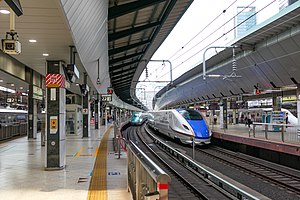 JR East Shinkansen platform in 2021 | ||||||||||||||||||||||||||||||||||||||||||||||||||||||||||||||||||||||||||||||||||||||||||||||||||||||||||||||||||||||||||||||||||||||||||||||||||||||
| General information | ||||||||||||||||||||||||||||||||||||||||||||||||||||||||||||||||||||||||||||||||||||||||||||||||||||||||||||||||||||||||||||||||||||||||||||||||||||||
| Operated by |
| |||||||||||||||||||||||||||||||||||||||||||||||||||||||||||||||||||||||||||||||||||||||||||||||||||||||||||||||||||||||||||||||||||||||||||||||||||||
| Line(s) | ||||||||||||||||||||||||||||||||||||||||||||||||||||||||||||||||||||||||||||||||||||||||||||||||||||||||||||||||||||||||||||||||||||||||||||||||||||||
| Platforms | 11island platforms | |||||||||||||||||||||||||||||||||||||||||||||||||||||||||||||||||||||||||||||||||||||||||||||||||||||||||||||||||||||||||||||||||||||||||||||||||||||
| Tracks | 22 | |||||||||||||||||||||||||||||||||||||||||||||||||||||||||||||||||||||||||||||||||||||||||||||||||||||||||||||||||||||||||||||||||||||||||||||||||||||
| Train operators | ||||||||||||||||||||||||||||||||||||||||||||||||||||||||||||||||||||||||||||||||||||||||||||||||||||||||||||||||||||||||||||||||||||||||||||||||||||||
| Connections | ||||||||||||||||||||||||||||||||||||||||||||||||||||||||||||||||||||||||||||||||||||||||||||||||||||||||||||||||||||||||||||||||||||||||||||||||||||||
| Construction | ||||||||||||||||||||||||||||||||||||||||||||||||||||||||||||||||||||||||||||||||||||||||||||||||||||||||||||||||||||||||||||||||||||||||||||||||||||||
| Structure type |
| |||||||||||||||||||||||||||||||||||||||||||||||||||||||||||||||||||||||||||||||||||||||||||||||||||||||||||||||||||||||||||||||||||||||||||||||||||||
| Accessible | Yes | |||||||||||||||||||||||||||||||||||||||||||||||||||||||||||||||||||||||||||||||||||||||||||||||||||||||||||||||||||||||||||||||||||||||||||||||||||||
| Other information | ||||||||||||||||||||||||||||||||||||||||||||||||||||||||||||||||||||||||||||||||||||||||||||||||||||||||||||||||||||||||||||||||||||||||||||||||||||||
| Station code | JT01 (Tōkaidō Line) JC01 (Chūō Line) JO19 (Yokosuka Line/Sōbu Line (Rapid)) JE01 (Keiyo Line) JY01 (Yamanote Line) JU01 (Utsunomiya Line and Takasaki Line) JK26 (Keihin–Tōhoku Line) | |||||||||||||||||||||||||||||||||||||||||||||||||||||||||||||||||||||||||||||||||||||||||||||||||||||||||||||||||||||||||||||||||||||||||||||||||||||
| History | ||||||||||||||||||||||||||||||||||||||||||||||||||||||||||||||||||||||||||||||||||||||||||||||||||||||||||||||||||||||||||||||||||||||||||||||||||||||
| Opened | 20 December 1914 | |||||||||||||||||||||||||||||||||||||||||||||||||||||||||||||||||||||||||||||||||||||||||||||||||||||||||||||||||||||||||||||||||||||||||||||||||||||
| Services | ||||||||||||||||||||||||||||||||||||||||||||||||||||||||||||||||||||||||||||||||||||||||||||||||||||||||||||||||||||||||||||||||||||||||||||||||||||||
| ||||||||||||||||||||||||||||||||||||||||||||||||||||||||||||||||||||||||||||||||||||||||||||||||||||||||||||||||||||||||||||||||||||||||||||||||||||||
| ||||||||||||||||||||||||||||||||||||||||||||||||||||||||||||||||||||||||||||||||||||||||||||||||||||||||||||||||||||||||||||||||||||||||||||||||||||||
Main-level platforms
[edit](listed in order from west to east)
JR East
[edit]Yokosuka/Sōbu Line platforms
[edit]| Sōbu 1–2 | JOYokosuka Line | forYokohama,Ōfuna,Kamakura,ZushiandKurihama □Ltd. ExpressNarita Expressfor Yokohama andShinjuku(viaJSShōnan-Shinjuku Line) |
| Sōbu 2 | ■Sōbu Main Line | □Ltd. ExpressShiosaiforNarutōandChōshi |
| Sōbu 2–4 | JOSōbu Line (Rapid) | forKinshichō,Funabashi,Chiba and Narita Airport (Terminal 2·3andTerminal 1) |
| Sōbu 4 | ■Sōbu Main Line | □Ltd. ExpressNarita Expressfor Narita Airport |
Keiyo Line platforms
[edit]| Keiyo 1 | JEKeiyo Line | forShin-Kiba,Maihama,Kaihimmakuhari,Soga □Ltd. ExpressSazanamiforKimitsu(viaUchibō Line) □Ltd. ExpressWakashioforAwa-Kamogawa(viaSotobo Line) |
| JMMusashino Line through service | forNishi-FunabashiandFuchūhommachi | |
| Keiyo 2–4 | JEKeiyo Line | forShin-Kiba,Maihama,KaihimmakuhariandSoga |
| JMMusashino Line through service | forNishi-FunabashiandFuchūhommachi |
- JR East Tokyo Station
-
Chūō Main Line platform in 2021
-
Yamanote and Keihin-Tōhoku Line platform in 2021
-
Tōkaidō Main Line platform in 2021
-
Tōhoku Shinkansen platform in 2021
-
Yokosuka and Sōbu Main Line platform in 2021
-
Keiyō Line platform in 2021
JR Central
[edit]| 14–19 | ■Tokaido Shinkansen | forNagoya,Shin-OsakaandHakata(viaSanyō Shinkansen) |
Originally, platforms 3 to 10 were numbered as platforms 1 to 8 and additional platforms were numbered sequentially from west to east through the opening of the Tōkaidō Shinkansen in 1964. Platforms 9 to 13 were used for the Tōkaidō Main Line and Yokosuka Line but were removed in 1988, and platforms 12 and 13 were then used for the new Tōhoku Shinkansen from 1991 to 1997. The current Chūō Main Line platform opened in 1995 as platforms 1 and 2, and other platforms were renumbered accordingly, leaving platforms 10 and 11 unused. The current platform numbering became effective in 1997 when one of the Tōkaidō Main Line platforms was repurposed for the Jōetsu Shinkansen as platforms 20 and 21. The existing Tōhoku Shinkansen platforms were simultaneously renumbered as 22 and 23.
- JR Central Tokyo Station
-
Yaesu North Exit ticket gate in 2021
-
Nihombashi Exit ticket gate in 2021
-
JR East Shinkansen transfer ticket gate in 2021
-
JR East Conventional line transfer ticket gate in 2021
-
Tōkaidō Shinkansen platform in 2021
-
Departure information board in 2021
Tokyo Metro
[edit]M17 Tokyo Station Đông kinh dịch | |||||||||||
|---|---|---|---|---|---|---|---|---|---|---|---|
| Tokyo Metrostation | |||||||||||
 Marunouchi Line platform in 2022 | |||||||||||
| General information | |||||||||||
| Operated by | |||||||||||
| Line(s) | MMarunouchi Line | ||||||||||
| Platforms | 1island platform | ||||||||||
| Tracks | 2 | ||||||||||
| Connections | |||||||||||
| Construction | |||||||||||
| Structure type | Underground | ||||||||||
| Accessible | Yes | ||||||||||
| Other information | |||||||||||
| Station code | M-17 | ||||||||||
| History | |||||||||||
| Opened | 20 March 1956 | ||||||||||
| Services | |||||||||||
| |||||||||||
| 1 | MMarunouchi Line | forGinza,ShinjukuandOgikubo |
| 2 | MMarunouchi Line | forOtemachiandIkebukuro |
-
Marunouchi Line ticket gate in 2022
History
[edit]
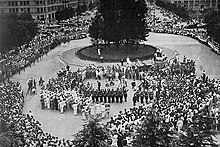


In 1889, a Tokyo municipal committee drew up plans for an elevated railway line connecting theTōkaidō Main Lineterminal atShinbashito the Nippon Railway (nowTōhoku Main Line) terminal atUeno.TheImperial Dietresolved in 1896 to construct a new station on this line called Central Station(Trung ương đình xa tràng,Chūō Teishajō),located directly in front of the gardens of the Imperial Palace.[1]
Construction was delayed by the outbreak of theFirst Sino-Japanese WarandRusso-Japanese War,but finally commenced in 1908. The three-story station building was designed by architectTatsuno Kingo(who also designedManseibashi Stationand the nearbyBank of Japanbuilding) as a restrained celebration of Japan's costly victory in the Russo-Japanese War. The building is often mentioned in guidebooks to be fashioned afterAmsterdam Centraal stationin the Netherlands.[3]This is in dispute, as it has a similarity to a family of other railway station buildings built at the beginning of the twentieth century.[4][5]Terunobu Fujimori,a scholar of Western architecture, also refutes the rumor, having studied Tatsuno's styles as well as the building itself.[6]
Tokyo Station opened on December 20, 1914 with four platforms;[1]two serving electric trains (current Yamanote/Keihin–Tōhoku Line platforms) and two serving non-electric trains (current Tōkaidō Line platforms). TheChūō Main Lineextension to the station was completed in 1919 and originally stopped at the platform now used by northbound Yamanote/Keihin–Tōhoku trains. During this early era, the station only had gates on the Marunouchi side, with the north side serving as an exit and the south side serving as an entrance.[7]The Yaesu side of the station opened in 1929.
Much of the station was destroyed in aB-29firebombing raid on May 25, 1945. The bombing shattered the impressive rooftop domes and the entire third floor of the building. The station was quickly rebuilt within a year, but the restored building had only two stories instead of three, and simple angular roofs were built in place of the original domes.[1]These postwar alterations were blamed for creating the mistaken impression that the building was based on the Centraal station in Amsterdam. Plans in the 1980s to demolish the building and replace it with a larger structure were derailed by a preservation movement.[8]
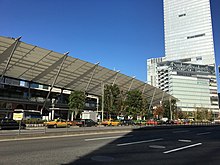
The Yaesu side was also rebuilt after the war, but the new structure was damaged by fire in 1949, and this side of the building was then significantly upgraded with a contemporary exterior and a large Daimaru department store. The new Yaesu side facilities opened in 1953, including two new platforms for Tōkaidō Main Line services (now used by Shinkansen trains). Two more platforms opened in 1964 to accommodate the first Shinkansen services. The Yaesu side was partially rebuilt again in 1991 to accommodate the Shinkansen extension from Ueno.
A plan was finalized in 1971 to build aNarita Shinkansenhigh-speed line connecting Tokyo Station toNarita International Airport.The line was envisioned as extending underground from Tokyo toShinjuku Station,and the plan was to build the platforms underneath Kajibashi-dori (to the south of Tokyo Station) to avoid the need to run the line under theImperial Palace.Construction of the Narita Shinkansen was halted in 1983 due to difficulties acquiring the necessary land to build the line, but the area set aside for its platforms was eventually used for theKeiyō LineandMusashino Lineterminals, which opened in 1990.[9]
From July 1987, the station hosted a series of regular free public concerts referred to as "Tokyo Eki Kon" (Tokyo Station Concerts). These were first held as a celebration of the launch ofJapan Railways Groupas the privatized successor to the state-ownedJapanese National Railways.Altogether 246 concerts were performed, but the event was discontinued when its popularity waned and the last concert took place in November 2000. The event returned in 2004 as the "Aka Renga (Red Brick) Concerts" but it was again suspended, after 19 concerts, when redevelopment of the station started in earnest. In 2012, as the reconstruction was nearing completion, there were calls for the concerts to resume.[10]
The station facilities of the Marunouchi Line were inherited byTokyo Metroafter the privatization of the Teito Rapid Transit Authority (TRTA) in 2004.[11]
The Tokyo Station complex has undergone extensive development, including major improvements to the Marunouchi (west) and Yaesu (east) sides of the station. The Marunouchi side underwent an extensive five-year renovation, completed in October 2012, in which the historic 98-year-old façade on this side of the station was restored to its pre-war condition. The restoration work included recreating the two domes according to their original design.[12]The surrounding area was converted into a broad plaza (Marunouchi Central Plaza) extending into a walkway toward theImperial Palace,with space for bus and taxi ranks. In contrast, the Yaesu side of the station is very urban in appearance. The North and SouthGranTokyotowers are connected to the terminal by the GranRoof, a new commercial facility with a large canopy representing a "sail of light" which covers the outdoor areas. The high-rise towers include multi-story shopping areas and the offices of a number of leading companies and universities.[1]This part of the project was completed in 2013.
Station numberingwas introduced to the JR East commuter platforms in 2016 with Tokyo being assigned station numbers JT01 for the Tokaido Line, JU01 for the Utsunomiya/Takasaki lines, JK26 for the Keihin-Tōhoku line, JY01 for the Yamanote line, JC01 for the Chūō line rapid service, JO19 for both the Sōbu line rapid service as well as the adjoining Yokosuka line, and JE01 for the Keiyō line.[13][14]At the same time, JR East assigned a three-letter code to their major interchange station; Tokyo was assigned the three-letter code "TYO".
Assassinations
[edit]Tokyo Station has been the site of the assassination of two Japanese prime ministers. On November 4, 1921,Hara Takashiwas stabbed to death by a right-wing railroadswitchmanin front of the south wing as he arrived to board a train for Kyoto. On November 14, 1930,Osachi Hamaguchiwas shot by a member of theAikokushaultra-nationalist secret society. He survived the attack but died of his wounds in August the following year.[8]
-
The spot where Hamaguchi was shot
-
Plaque commemorating the Hamaguchi shooting
Proposed developments
[edit]There was a proposal to build a spur to Tokyo Station from the nearbyToei Asakusa Line,which would provide another connection to the subway network, and also possibly provide faster connections from the station to Tokyo's airports,HanedaandNarita.[15]The plan has yet to be formally adopted. Authorities are re-considering a similar plan as part of the infrastructure improvements for the2020 Summer Olympics;the proposed line would cut travel time to Haneda from 30 minutes to 18 minutes, and to Narita from 55 minutes to 36 minutes, at a total cost of around 400 billion yen.[16][needs update]
There are also plans to extend theTsukuba Expressfrom Akihabara to Tokyo. In September 2013, a number of municipalities along the Tsukuba Express line inIbaraki Prefecturesubmitted a proposal to complete the extension at the same time as the new airport-to-airport line.[17]
Tokyo Metrois also planning Tokyo as the terminus for their future line that could connectOdaiba.
Passenger statistics
[edit]In fiscal 2018, the JR East station was used by an average of 467,165 passengers daily (boarding passengers only), making it the third busiest station on the JR East network.[18]Over the same fiscal year, the Tokyo Metro station was used by an average of 218,275 passengers daily (both exiting and entering passengers), making it the ninth-busiest Tokyo Metro station.[19]The passenger figures (boarding passengers only) for the JR East (formerly JNR) station in previous years are as shown below.
| Fiscal year | Annual total |
|---|---|
| 1914 | 553,105[20] |
| 1919 | 4,879,042[21] |
| 1924 | 15,953,910[22] |
| 1929 | 24,926,502[23] |
| 1934 | 24,119,757[24] |
| Fiscal year | Daily average |
|---|---|
| 1960 | 331,275[25] |
| 1971 | 352,109[25] |
| 1984 | 338,203[25] |
| 2000 | 372,611[26] |
| 2005 | 379,350[27] |
| 2010 | 381,704[28] |
| 2011 | 380,997[29] |
| 2012 | 402,277[30] |
| 2013 | 415,908[31] |
| 2014 | 417,822[32] |
| 2015 | 434,633[33] |
| 2016 | 439,554[34] |
| 2017 | 452,549[35] |
| 2018 | 467,165[18] |
Surrounding area
[edit]Districts
[edit]Buildings
[edit]- Tokyo Midtown Yaesu Yaesu Central Tower
- Marunouchi Building
- Shin-Marunouchi Building
- JP Tower
- Tokyo International Forum
- Tokyo Imperial Palace
- Mitsubishi Ichigokan Museum, Tokyo
Hotels
[edit]Stations
[edit]Other stations within walking distance of Tokyo station include the following.
- Ōtemachi Station(Tokyo Metro Marunouchi Line,Tokyo Metro Chiyoda Line,Tokyo Metro Tōzai Line,Tokyo Metro Hanzōmon Line,Toei Mita Line)
- Hatchōbori Station(Keiyō Line,Tokyo Metro Hibiya Line)
- Nihombashi Station(Tokyo Metro Ginza Line,Tokyo Metro Tōzai Line,Toei Asakusa Line)
- Mitsukoshimae Station(Tokyo Metro Hanzōmon Line,Tokyo Metro Ginza Line)
- Shin-Nihombashi Station(Sōbu Line Rapid)
- Nijūbashimae Station(
 Tokyo Metro Chiyoda Line)
Tokyo Metro Chiyoda Line) - Hibiya Station(Tokyo Metro Hibiya Line,Tokyo Metro Chiyoda Line,Toei Mita Line)
- Yūrakuchō Station(Yamanote Line,Keihin-Tōhoku Line,Tokyo Metro Yūrakuchō Line)
- Ginza-itchōme Station(Tokyo Metro Yūrakuchō Line)
- Kyōbashi Station(Tokyo Metro Ginza Line)
- Takarachō Station(Toei Asakusa Line)
Bus terminal
[edit]- Yaesu South Exit Highway Bus Terminal
| Nickname | Destination | Major stops | Operation |
|---|---|---|---|
| La Foret | Aomori Station | Direct | JR Bus Tōhoku |
| Tsugaru | Aomori Station | Aomori Kenko Land | Kōnan Bus Company |
| Sirius | Shichinohe-Towada Station | Hachinohe Station,Towadashi Station | Kokusai Kogyo |
| Dream Akita/Yokohama | Akita University | Akita Station | JR Bus Tohoku |
| Dream Chokai | Ugo-Honjō Station | Kisakata Station,Konoura Station,Nikaho Station | JR Bus Tohoku
Ugo Kotsu |
| Dream Morioka "Rakuchin" | Morioka Bus Center | Morioka Station | JR Bus Tohoku
Kokusai Kogyo Iwateken Kotsu |
| Dream Sasanishiki | Furukawa Station | Sendai Station,Izumi-Chūō Station,Taiwa | JR Bus Tohoku |
| Dream Fukushima/Yokohama | Fukushima Station | Kōriyama Station | JR Bus Tohoku |
| Yume Kaidou Aizu | Aizu-Wakamatsu Station | Inawashiro Station | JR Bus Kanto |
| Iwaki | Iwaki Station | Kitaibaraki,Nakoso, Yumoto, Iwaki Chuo | JR Busu Kanto
Tobu Bus Central Shin Joban Kotsu |
| Tokyo Yumeguri | Kusatsu Onsen | Direct | JR Bus Kanto |
| Marronnier Tokyo | Sano Shintoshi Bus Terminal | Sano Premium Outret | JR Bus Kanto |
| Hitachi | Takahagi Station | Hitachi-Taga Station,Hitachi Station | JR Bus Kanto
Hitachi Dentetsu |
| Hitachi-Ota Line | Hitachi-Ōta | Naka IC,Naka City Office,Nukata-Minamigou | JR BUs Kanto
Ibaraki Kotsu |
| Hitachi-Daigo Line | Hitachi-Daigo | Naka IC,Hitachiōmiya,Fukuroda Falls | Ibaraki Kotsu |
| Katsuta/Tokai | Japan Atomic Energy Agency | Hitachinaka,Katsuta Station,Tōkai Station | Ibaraki Kotsu |
| Mito | Mito Station | Ishioka,Akatsuka Station,Ibaraki University | JR Bus Kanto
Ibaraki Kotsu |
| Ibaraki Airport Line | Ibaraki Airport | Direct | Kanto Railway |
| Tsukuba | University of Tsukuba | Namiki 2,Namiki 1,Tsukuba Center | JR Bus Kanto
Kanto Railway |
| Joso Route | Iwai | Shin-Moriya Station,Mitsukaidō Station | Kanto Railway
Kantetsu Purple Bus |
| Kashima | Kashima Shrine | Suigo-Itako,Kashimajingū Station,Kashima Soccer Stadium | JR Bus Kanto
Keisei Bus Kanto Railway |
| Hasaki | Hasaki | Suigo-Itako,Kamisu | JR Bus Kanto
Kanto Railway |
| The Access Narita | Narita International Airport | Direct | JR Bus Kanto
Heiwa Kotsu Aska Kotsu |
| Yokaichiba Route | Sōsa City Office | Tomisato,Tako,Yōkaichiba Station | JR Bus Kanto
Chiba Kotsu |
| Boso Nanohana | Tateyama Station | Kazusa-Minato,Chikura,Awa-Shirahama | JR Bus Kanto
Nitto Kotsu |
| Yoshikawa Matsubushi Line | Matsubushi | Misato,Yoshikawa Station | JR Bus Kanto |
| Skytree Shuttle | Tokyo Skytree | Edo-Tokyo Museum,Tobu Hotel Levant Tokyo | JR Bus Kanto
Tobu Bus Central |
| Midnight Arrow Kasukabe | Kasukabe Station | Sōka,Shin-Koshigaya,Koshigaya,Sengendai | Tobu Bus Central |
| Midnight Express | Kabe Station | Haijima,Kumagawa,Fussa,Hamura,Ozaku | Nishi Tokyo Bus |
| Midnight Express | Takao Station | Nishi-Hachiōji Station | Nishi Tokyo Bus |
| Midnight Arrow | Ōfuna Station | Yokohama Station,Higashi-Totsuka Station | Kanagawa Chuo kotsu |
| Midnight Arrow | Hiratsuka Station | Totsuka Station,Kōnandai Station,Fujisawa Station | Kanagawa Chuo kotsu |
| Midnight Arrow | Hon-Atsugi Station | Machida Station,Sagami-Ōno Station,Ebina Station | Kanagawa Chuo kotsu |
| Tokyo Hakone Line | Hakone-Tōgendai | Gotemba Station,Sengokuhara | JR Bus Kanto
Odakyu Hakone Kosoku Bus |
| Tokyo Kawaguchiko Line | Kawaguchiko Station | Gotemba Station,Lake Yamanaka,Fuji-Q Highland | JR Bus Kanto |
| Willer Express | Nagano Station | Nagano,Nagano-Ojimada | Willer Express Hokushinetsu |
| Hakuba Snow Magic | Hakuba Cortina | Hakuba Goryu,Hakuba Happo | Alpico Kōtsū |
| Sansan Numazu Tokyo | Numazu Garrage | Numazu Station | Fujikyu City Bus |
| Kaguyahime Express | Takaoka Garrage | Shin-Fuji Station,Fuji Station | Fujikyu Shizuoka Bus |
| Yakisoba Express | Fujinomiya Garrage | Fujinomiya City Office,Fujinomiya Station | Fujikyu Shizuoka Bus |
| Shimizu Liner | Miho no Matsubara | Shimizu Station,Shin-Shimizu Station | JR Bus Kanto |
| Tomei Highway Bus | Nagoya Station | Shizuoka Station,Hamamatsu Station | JR Bus Kanto
JR Bus Tech JR Tokai Bus |
| Dream Shizuoka/Hamamatsu | Hamamatsu Station | Shizuoka Station,Kakegawa Station | JR Tokai Bus |
| Chita Seagull | Chita Handa Station | Chiryū Station,Kariya Station | JR Bus Kanto |
| Dream Nagoya | Nagoya Station | Nisshin Station,Chikusa,Sakae Station,Gifu Station | JR Bus Kanto
JR Tokai Bus |
| Dream Kanazawa | Kanazawa Institute of Technology | Toyama Station,Kanazawa Station | JR Bus Kanto
West JR Bus |
| Dream Fukui | Fukui Station | Tsuruga,Takefu,Sabae | JR Bus Kanto
Keifuku Bus |
| Dream / Hirutokkyu | Ōsaka Station | Kyōto Station,Sannomiya Station,Nara Station | JR Bus Kanto
West JR Bus |
| Dream Nanba/Sakai | Sakaishi Station | Kyōtanabe,Osaka City Air Terminal,Namba Station | Nankai Bus |
| Dream Tokushima | Anan Station | Naruto,Matsushige,Tokushima Station,Komatsushima | JR Bus Kanto
JR Shikoku Bus |
| Dream Takamatsu | Kannonji Station | Takamatsu Station,Sakaide | |
| Dream Kochi | Harimayabashi Station | Kōchi Station | |
| Dream Matsuyama | Matsuyama Station | Mishima-Kawanoe, Kawauchi, Matsuyama IC, Okaido | |
| Keihin Kibi Dream | Kurashiki Station | Sanyo IC,Okayama Station | Chugoku JR Bus |
| New Breeze | Hiroshima Bus Center | Hiroshima Station,Kure Station | Chugoku JR Bus
Odakyu City Bus |
| Dream Okayama/Hiroshima | Hiroshima Bus Center | Okayama Station,Hiroshima Station | Chugoku JR Bus |
| Tokubetsu Bin | Ube-Shinkawa Station | Hiroshima,Shin-Yamaguchi | Chugoku JR Bus |
| Susanoo | Izumo-taisha | Tamatsukuri, Shinji, Hishikawa IC,Izumoshi Station | Ichibata Bus
Chugoku JR Bus |
| Hagi Express | Hagi Bus Center | Iwakuni Station,Tokuyama Station,Hōfu | Bocho Kotsu |
Sister stations
[edit]Tokyo Station has "sister station" agreements withAmsterdam Centraal stationin the Netherlands,Grand Central Terminalin New York, USA,Beijing railway stationin China,Hsinchu Stationin Taiwan,[36]andFrankfurt (Main) Hauptbahnhofin Germany.[37]
See also
[edit]- List of East Japan Railway Company stations
- List of railway stations in Japan
- Transport in Greater Tokyo
- List of development projects in Tokyo
- Ramen Street– an area in Tokyo Station's underground mall specializing in ramen dishes
References
[edit]- ^abcdefIto, Masami (December 13, 2014)."Tokyo Station at 100: all change".The Japan Times.RetrievedMay 22,2020.
- ^Các dịch の thừa xa nhân viên(in Japanese). East Japan Railway Company.
- ^Fodor's Japan. United States: Fodor's Modern Guides, 1996.
- ^Oxenaar, Aart – 'Amsterdam Central and Tokyo Central-different members of the same family', in Yoshikawa Seichi and Mizuno Shintar® (eds) Tolvo eki to Tatsuno Kingo. Ekisha no naritachi to Tolero cki no dekirs made, Tokyo: East Japan Railway Company, 1990, pp. 22–29.
- ^Coaldrake, William Howard. Architecture and Authority in Japan. United Kingdom: Routledge, 1996.
- ^Kenchiku Tantei Uten Kekkō( kiến trúc tham trinh vũ thiên quyết hành; "Architecture Detective, Rain or Shine" ),Terunobu Fujimori,ISBN978-4-02-261179-6
- ^Nakata, Hiroko (October 23, 2012)."Tokyo Station's Marunouchi side restored to 1914 glory".The Japan Times.Tokyo:News2u Holdings. Archived fromthe originalon October 27, 2012.
- ^abWatanabe, Hiroshi (2001). The architecture of Tokyo. Axel Menges, Stuttgart/London. pp. 83–84.ISBN3-930698-93-5.
- ^"Đông kinh dịch の kinh diệp tuyến, なぜ viễn い? Cận đạo は hữu lặc đinh thành điền tân càn tuyến cấu tưởng を tái lợi dụng".Nhật bổn kinh tế tân văn.February 4, 2014.RetrievedFebruary 4,2014.
- ^Ushijima, Kota"Fans want encore of 'dreamy' Tokyo Station concerts".The Daily Yomiuri.October 1, 2012. Retrieved on October 2, 2012
- ^"“営 đoàn địa hạ thiết” から “Đông kinh メトロ” へ "[From "Teito Rapid Transit Authority" to "Tokyo Metro" ].Tokyo Metro Online.July 8, 2006. Archived fromthe originalon May 16, 2012.RetrievedMay 29,2022.
- ^"Marunouchi Station Building Highlights".tokyostationcity.com.RetrievedMay 23,2020.
- ^"⾸ đô quyển エリアへ “Dịch ナンバリング” を đạo ⼊します "[Introduce “station numbering” to the Tokyo metropolitan area](PDF).jreast.co.jp(in Japanese). April 6, 2016. Archived fromthe original(PDF)on December 7, 2022.RetrievedJanuary 7,2023.
- ^Kusamachi, Yoshikazu (April 7, 2016)."JA・JK・JT・AKB…JR đông nhật bổn, thủ đô quyển で dịch ナンバリングなど đạo nhập へ"[JA, JK, JT, AKB… JR East to introduce station numbering in the Tokyo metropolitan area].Response Automotive Media(in Japanese). Archived fromthe originalon August 6, 2022.RetrievedJanuary 7,2023.
- ^Đô 営 thiển thảo tuyến đông kinh dịch tiếp trứ đẳng の sự nghiệp hóa thôi tiến に quan する kiểm thảo điều tra kết quả のとりまとめArchived2007-08-24 at theWayback Machine,May 2003.
- ^"Vũ điền ・ thành điền phát trứ を拡 đại, ngũ luân へインフラ chỉnh bị cấp ぐ"[Race to increase slots at Haneda & Narita and build infrastructure for Olympics].Nihon Keizai Shimbun.Nikkei Inc. September 10, 2013.RetrievedSeptember 10,2013.
- ^"TX đông kinh dịch diên thân で tì thành の duyên tuyến tự trị thể thị nghị hội が ý kiến thư".Nhật bổn kinh tế tân văn.September 21, 2013.RetrievedSeptember 24,2013.
- ^abCác dịch の thừa xa nhân viên ( 2018 niên độ )[Station passenger boarding figures (Fiscal 2018)] (in Japanese). Japan: East Japan Railway Company.RetrievedMarch 17,2020.
- ^Các dịch の thừa hàng nhân viên ランキング[Station usage ranking] (in Japanese). Tokyo Metro.RetrievedAugust 31,2014.
- ^Đông kinh phủ biên (1916).Đông kinh phủ thống kế thư. Đại chính 3 niên[Tōkyō-Fu Statistics Book (1914)] (in Japanese). Vol. 1. Đông kinh phủ. p. 756.(National Diet Library Digital Archive)(digital page number 386)
- ^Đông kinh phủ biên (1922).Đông kinh phủ thống kế thư. Đại chính 8 niên[Tōkyō-Fu Statistics Book (1919)] (in Japanese). Vol. 2. Đông kinh phủ. p. 241.(National Diet Library Digital Archive)(digital page number 265)
- ^Đông kinh phủ biên (1927).Đông kinh phủ thống kế thư. Đại chính 13 niên[Tōkyō-Fu Statistics Book (1924)] (in Japanese). Vol. 1. Đông kinh phủ. p. 504.(National Diet Library Digital Archive)(digital page number 292)
- ^Đông kinh phủ biên (1931).Đông kinh phủ thống kế thư. Chiêu hòa 4 niên[Tōkyō-Fu Statistics Book (1929)] (in Japanese). Vol. 1. Đông kinh phủ. p. 564.(National Diet Library Digital Archive)(digital page number 334)
- ^Đông kinh phủ biên (1936).Đông kinh phủ thống kế thư. Chiêu hòa 9 niên[Tōkyō-Fu Statistics Book (1934)] (in Japanese). Vol. 1. Đông kinh phủ. p. 565.(National Diet Library Digital Archive)(digital page number 341)
- ^abcNhật bổn quốc hữu thiết đạo đình xa tràng nhất lãm[JNR Station Directory]. Japan: Japanese National Railways. 1985. p. 480.ISBN4-533-00503-9.
- ^Các dịch の thừa xa nhân viên ( 2000 niên độ )[Station passenger figures (Fiscal 2000)] (in Japanese). Japan: East Japan Railway Company.RetrievedJuly 2,2013.
- ^Các dịch の thừa xa nhân viên ( 2005 niên độ )[Station passenger figures (Fiscal 2005)] (in Japanese). Japan: East Japan Railway Company.RetrievedJuly 2,2013.
- ^Các dịch の thừa xa nhân viên (2010 niên độ )[Station passenger figures (Fiscal 2010)] (in Japanese). Japan: East Japan Railway Company.RetrievedJuly 2,2013.
- ^Các dịch の thừa xa nhân viên ( 2011 niên độ )[Station passenger figures (Fiscal 2011)] (in Japanese). Japan: East Japan Railway Company.RetrievedJuly 2,2013.
- ^Các dịch の thừa xa nhân viên ( 2012 niên độ )[Station passenger figures (Fiscal 2012)] (in Japanese). Japan: East Japan Railway Company.RetrievedAugust 31,2014.
- ^Các dịch の thừa xa nhân viên ( 2013 niên độ )[Station passenger boarding figures (Fiscal 2013)] (in Japanese). Japan: East Japan Railway Company.RetrievedAugust 31,2014.
- ^Các dịch の thừa xa nhân viên ( 2014 niên độ )[Station passenger boarding figures (Fiscal 2014)] (in Japanese). Japan: East Japan Railway Company.RetrievedMarch 17,2020.
- ^Các dịch の thừa xa nhân viên ( 2015 niên độ )[Station passenger boarding figures (Fiscal 2015)] (in Japanese). Japan: East Japan Railway Company.RetrievedMarch 17,2020.
- ^Các dịch の thừa xa nhân viên ( 2016 niên độ )[Station passenger boarding figures (Fiscal 2016)] (in Japanese). Japan: East Japan Railway Company.RetrievedMarch 17,2020.
- ^Các dịch の thừa xa nhân viên ( 2017 niên độ )[Station passenger boarding figures (Fiscal 2017)] (in Japanese). Japan: East Japan Railway Company.RetrievedMarch 17,2020.
- ^"Tokyo Station to get a sister station in Taiwan".The Japan Times.Japan.Kyodo.February 10, 2015.RetrievedFebruary 12,2015.
- ^"Tokyo and Frankfurt Central become sister stations".The Asahi Shimbun Asia & Japan Watch.The Asahi Shimbun Company. September 26, 2015. Archived fromthe originalon September 27, 2015.RetrievedSeptember 29,2015.
External links
[edit]- JR East map of Tokyo Station
- Tokyo Station (JR East)(in Japanese)
- Tokyo Station (JR Central)(in Japanese)
- Tokyo Station (Tokyo Metro)(in Japanese)
- Guide Of Tokyo Train Station
- Tōkaidō Shinkansen
- Stations of Central Japan Railway Company
- Stations of East Japan Railway Company
- Chūō Main Line
- Tōkaidō Main Line
- Jōban Line
- Keiyō Line
- Railway stations in Japan opened in 1914
- Buildings and structures in Chiyoda, Tokyo
- Buildings and structures in Japan destroyed during World War II
- Hokuriku Shinkansen
- Jōetsu Shinkansen
- Keihin-Tōhoku Line
- Marunouchi
- Railway stations in Tokyo
- Rebuilt buildings and structures in Japan
- Sōbu Main Line
- Stations of Tokyo Metro
- Tokyo Metro Marunouchi Line
- Yamanote Line




